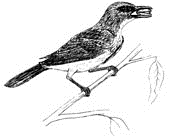Vertebrate Pest Conference Proceedings collection
Date of this Version
1996
Document Type
Article
Citation
Published in Proceedings: Seventeenth Vertebrate Pest Conference … 1996, ed. Robert M. Timm & A. Charles Crabb (University of California, Davis, 1996).
Abstract
To evaluate the potential of using nesting material as a medium for avicide delivery, five organophosphates (Dasanit®, Volaton®, fenthion, parathion, and Cyanophos®) were tested on small groups of paired male-female quelea (n = 4 to 9). Toxicants were presented to each pair of birds on five 13-cm strands of cotton string after a preliminary screening for male nest weaving behavior. Tested concentrations ranged from 100% technical grade to 0.003 % compound diluted with acetone. Dasanit® was found to be the most effective candidate with some lethal effects noted at 0.012%. An optimal concentration for Dasanit® was estimated to be 0.80% based on combined male and female mortality (72%). This level was further evaluated in two aviary cage tests using 25 male-female quelea pairs during three-day exposure periods. A first replication yielded mortality ratios of 23:25 (92%) for males, but mortality ratios of only 1:24 (4%) for females. The second replication yielded mortality ratios of 24:25 (96%) for males and 11:25 (44%) for females. Females in the second group showed more weaving attempts than those in the first replication group, which could explain the pronounced mortality difference. Safety concerns about the use of toxicant-laden nesting material have not yet been evaluated in Africa. These concerns need to be addressed relative to the knowledge and literacy level of the local people applying the materials and to their awareness of methods of limiting pesticide exposures to the general public.
Included in
Animal Sciences Commons, Bioresource and Agricultural Engineering Commons, Environmental Engineering Commons


Comments
Copyright © 1996 (where applicable) by the Vertebrate Pest Council of the Vertebrate Pest Conference. Used by permission.